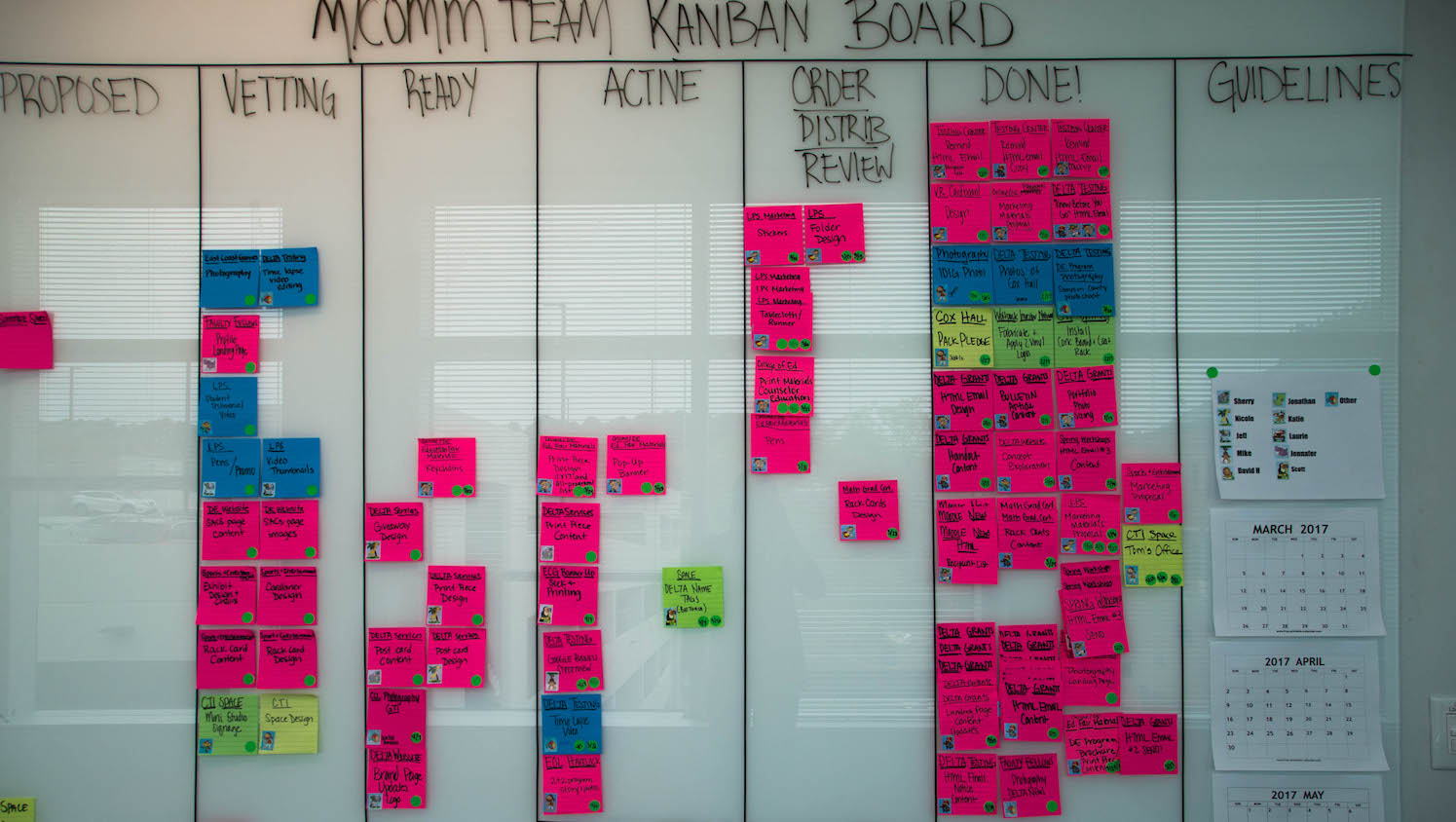Project Management System Assists DELTA Marketing and Communications Team

Over the past eight months, DELTA’s marketing and communications team incorporated the use of Kanban into their work in order to efficiently and effectively track ideas and project progression. Kanban, coming from the word “visual signal” or “card” in Japanese, is a project management technique that uses physical cards or notes to mark when a process or task needs to be done, when it is in process and when the task is complete. In doing this, employees can maximize their time on the job and increase work efficiency.
According to leankit.com, this visually based management system uses four core principles:
- visualize work
- limit work in process
- focus on flow and
- continuous improvement
These foundations are incorporated to help team members see potential threats to progress, track project movement, optimize its flow and measure effectiveness.
“Kanban gave us a way to merge multiple project-management techniques to visually represent it in a way that resonated and clicked for our designers,” said Laurie Gyalog, executive assistant of instructional technology support and development and current marketing and communications project coordinator.
Not only has Kanban been helpful in the office, it assisted in the organization of relocating the office as well. “Kanban was pivotal in promoting collaboration, efficiency and effectiveness across our team for the DELTA relocation to CTI. It allowed us to visually track over 80 tasks to be completed in 6 short weeks and aided in a shared vision and understanding of the work to be done,” said Gyalog.
So how does DELTA use Kanban?
The marketing and communications team currently uses three tools in particular to help monitor the flow of members’ ideas and work. The first is the intake form. “This form allows us to clarify project goals, budget support, final approvers, timeline, potential deliverables and much more. It sparks an immediate response from our project manager to thank our client for their request and let them know our team will follow-up within 24 hours,” said Gyalog.
After responding to clients, project coordinators work with our creative director and other team members to discuss the timeline for the proposed work and resource allocation. Clients are then contacted a second time to outline the next steps.
The second major tool used in the process is the whiteboard or Kanban board. Information about ideas and projects are written on sticky notes. These notes are then taken to the whiteboard and placed under one of several categories. These include Proposed, Vetting, Ready, Active, Customer Hands, Order/Distribution, Parking Lot and Done.
Sticky notes begin their journey on the board under the Proposed section. The information mentioned in meetings, in passing and by clients is placed here. This information moves to the Vetting column while it is further explored.
When a project has been fully defined, it moves to Ready and can be switched to Active at any time. If clients need to review any work, notes then go to Customer Hands, but if an order needs to be submitted or if completed materials need to be distributed, the notes move to Order/Distribution.
Projects may or may not move to the Parking Lot for a period of time. Sticky notes in this category relate to tasks that have been bottlenecked or briefly postponed; there is a limit of four spots.
The final and most rewarding column is Done! Sticky notes are placed here when projects are complete and can finally be celebrated.
TeamworkPM serves as the third side of the triangle. In this project management system, information regarding project team members, roles, project description, and start and end dates are all noted.
“This is the hub and the organizational visibility for all projects. All colleagues have access to view projects in this system at any time. In our support role as project coordinators, we ensure everything that is noted on the intake form and on the Kanban board is accounted for in the system,” said Gyalog.
Although the process may sound tedious, it has helped the marketing and communications team grow in four key areas: accountability, efficiency, collaboration and output. During short twice-weekly standing meetings, contributors are responsible for sharing what they are currently working on and take accountability for tasks assigned to them. “Everyone wants their projects on the board, and everyone wants to feel like they are contributing to the team,” said Gyalog.
The intake form, Kanban board and use of TeamworkPM have all increased efficiency by reducing the number of meetings required to gather project requirements, break down tasks and initiate work on projects. Transparency and face-to-face conversations have also improved collaboration, as team members volunteer to assist others with work when seeing a coworker’s task falling behind.
“The Kanban process connects all of our project management practices and increases efficiency and effectiveness of our project management support,” said Gyalog. This has resulted in numerous benefits including increased production and output.
According to David Howard, director of Innovation Instructional Services and lead of the marketing and communications teams, “The Kanban board was the final piece of the puzzle for us. We already used TeamworkPM but it didn’t give us a way to visualize the flow of projects. The intake form was our way to try to streamline the way that all projects and requests were initiated but no way to keep track after project initiation. The Kanban board gives us the missing piece; a way to maintain awareness of all the things that are going on, change priorities when necessary and understand what everyone is working on in a given week.”


